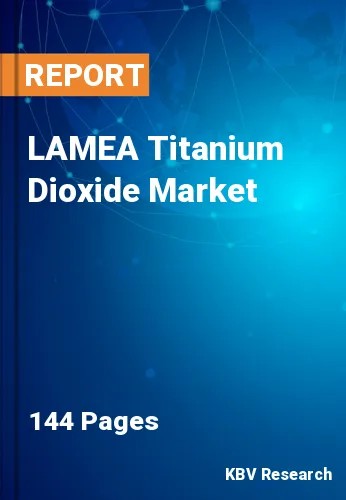The Latin America, Middle East and Africa Titanium Dioxide Market would witness market growth of 7.7% CAGR during the forecast period (2023-2030). In the year 2026, the LAMEA market's volume is expected to surge to 606.3 Kilo Tonnes, showcasing a growth of 6.6% (2023-2030).
The plastics industry has become a major consumer of titanium dioxide. TiO2 is employed as a white pigment in plastic products ranging from packaging materials and consumer goods to automotive components. The packaging sector, in particular, has witnessed substantial growth due to e-commerce, food packaging, and various consumer product applications. This has translated into an increased need for TiO2 to achieve the desired whiteness, opacity, and UV protection in plastic packaging materials.
Furthermore, the food and pharmaceutical industries have contributed to the rising demand for titanium dioxide. TiO2 is used as a food additive (E171) to provide whiteness and opacity in various food products, including candies, chocolates, and toothpaste. In the pharmaceutical sector, it is utilized in tablet coatings and as a colorant in capsules and ointments. In addition to its role as a whitening agent, TiO2 is utilized for its opacity and coverage properties. This is especially important in confectionery, where it helps maintain the appearance of color consistency and ensures that printed designs on candies remain vibrant and visually appealing.
The Middle East and Africa are essential mining centers, which means that the region's industries have easy and affordable access to raw materials, lowering the region's overall manufacturing costs. According to the Department of Trade, Industry and Competition of South Africa, the nation is the world's second-largest producer of minerals containing titanium, can advance the regional economy and generate much-needed employment there. The pigment industry consumes over 90% of all titanium feedstock, driving demand for titanium mineral concentrates. Titanium is vital to many consumer goods and industrial products, including paints, plastics, cosmetics, paper, rubber, ceramics, and textiles. Hence, the region presents lucrative growth prospects for the market.
The Brazil market dominated the LAMEA Titanium Dioxide Market, By Country in 2022, and would continue to be a dominant market till 2030; thereby, achieving a market value of $649.6 million by 2030. The Argentina market is showcasing a CAGR of 6.9% during (2023 - 2030). Additionally, The UAE market would register a CAGR of 8.4% during (2023 - 2030).
Based on Grade, the market is segmented into Rutile, and Anatase. Based on Production Process, the market is segmented into Sulfate, and Chloride. Based on Application, the market is segmented into Paints & Coatings, Plastics, Cosmetics, Pulp & Paper, and Others. Based on countries, the market is segmented into Brazil, Argentina, UAE, Saudi Arabia, South Africa, Nigeria, and Rest of LAMEA.
Free Valuable Insights: The Worldwide Titanium Dioxide Market is Projected to reach USD 31.4 Billion by 2030, at a CAGR of 6.4%
The market research report covers the analysis of key stake holders of the market. Key companies profiled in the report include Kronos Worldwide, Inc., The Chemours Company, Tronox Holdings Plc, Evonik Industries AG (RAG-Stiftung), LB Group, Venator Materials PLC, Ishihara Sangyo Kaisha, Ltd., TAYCA Corporation, CATHAY INDUSTRIES, and TOR Minerals International, Inc.
By Grade (Volume, Kilo Tonnes, USD Million, 2019-2030)
By Production Process (Volume, Kilo Tonnes, USD Million, 2019-2030)
By Application (Volume, Kilo Tonnes, USD Million, 2019-2030)
By Country (Volume, Kilo Tonnes, USD Million, 2019-2030)
Our team of dedicated experts can provide you with attractive expansion opportunities for your business.

